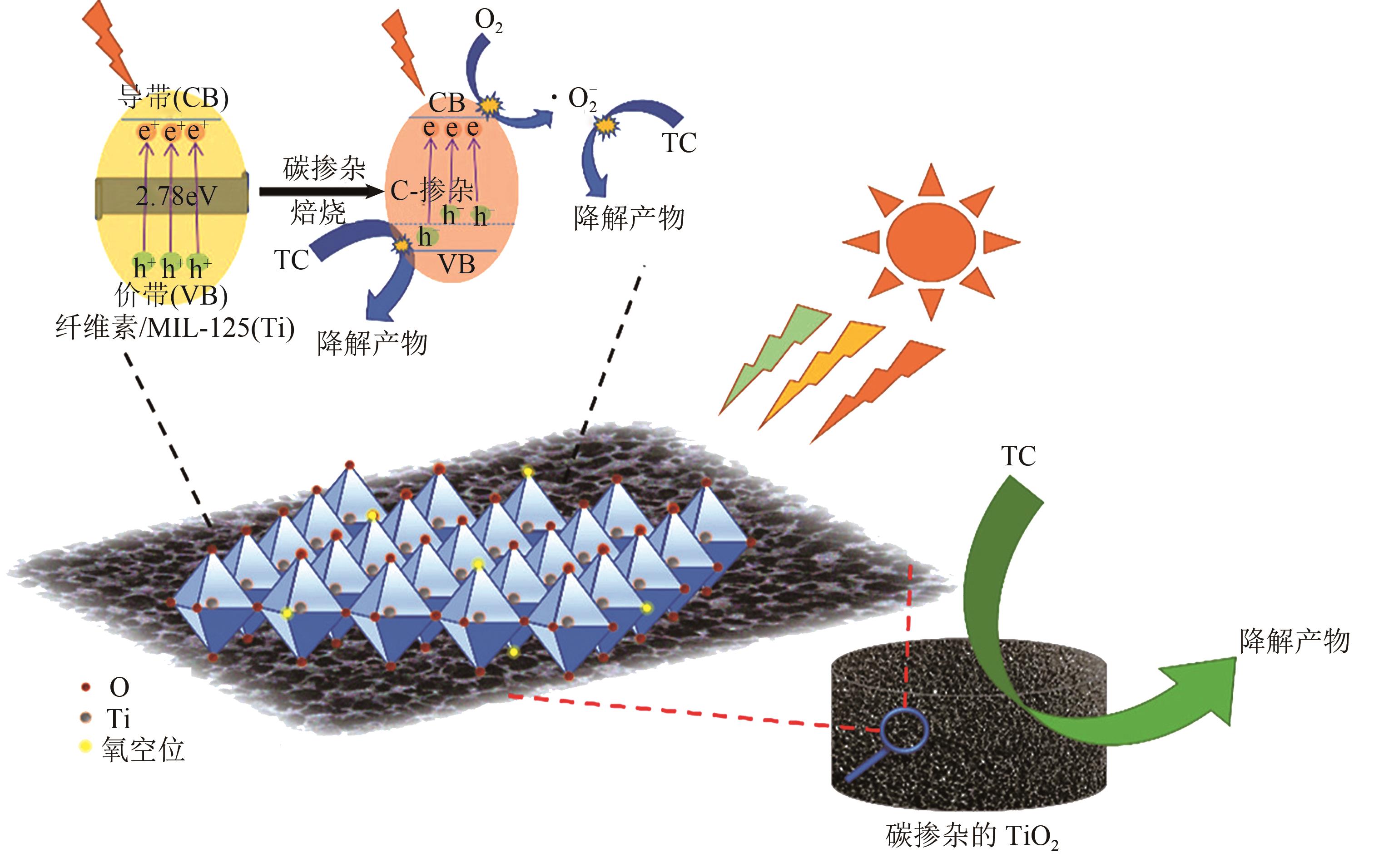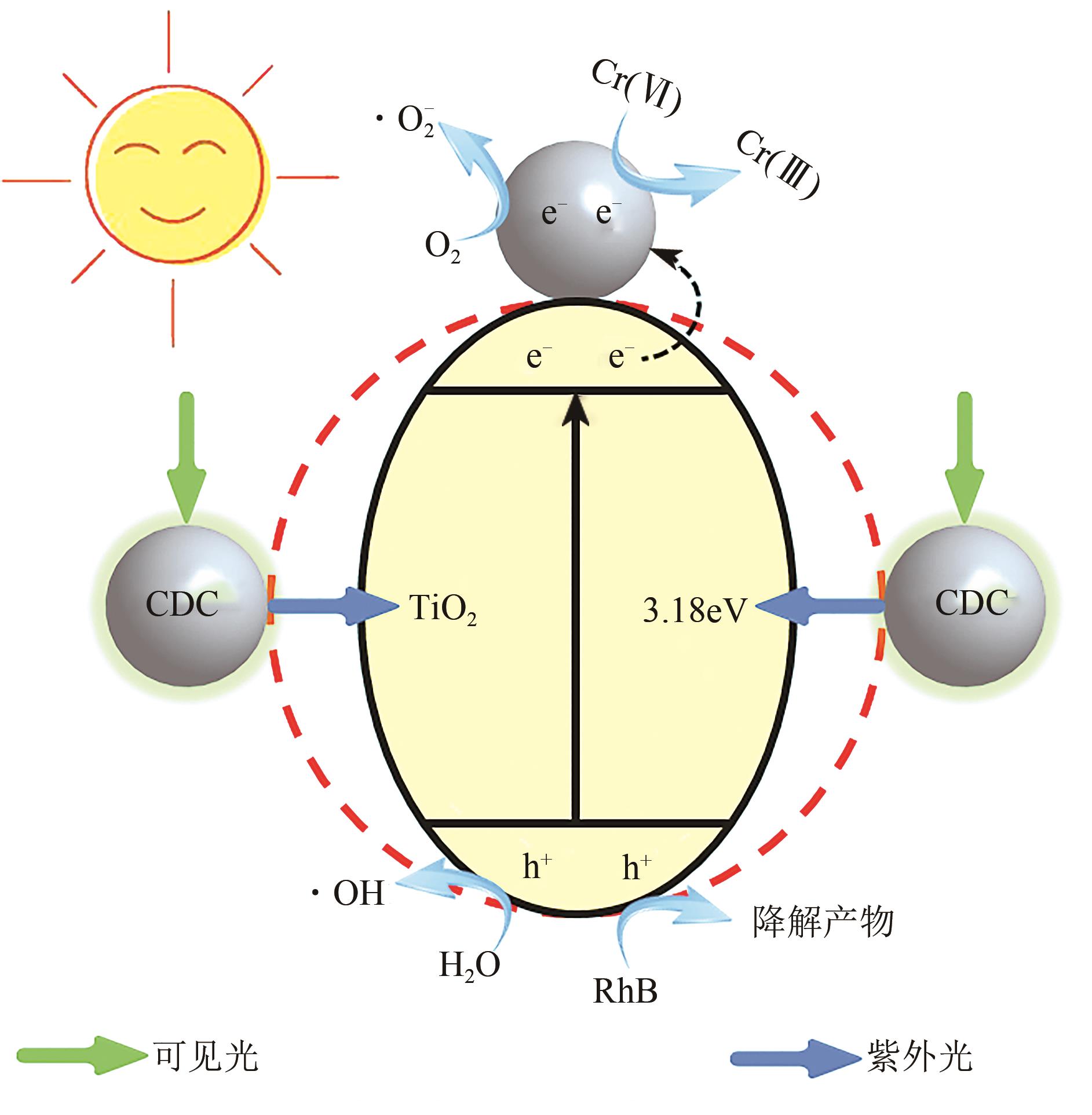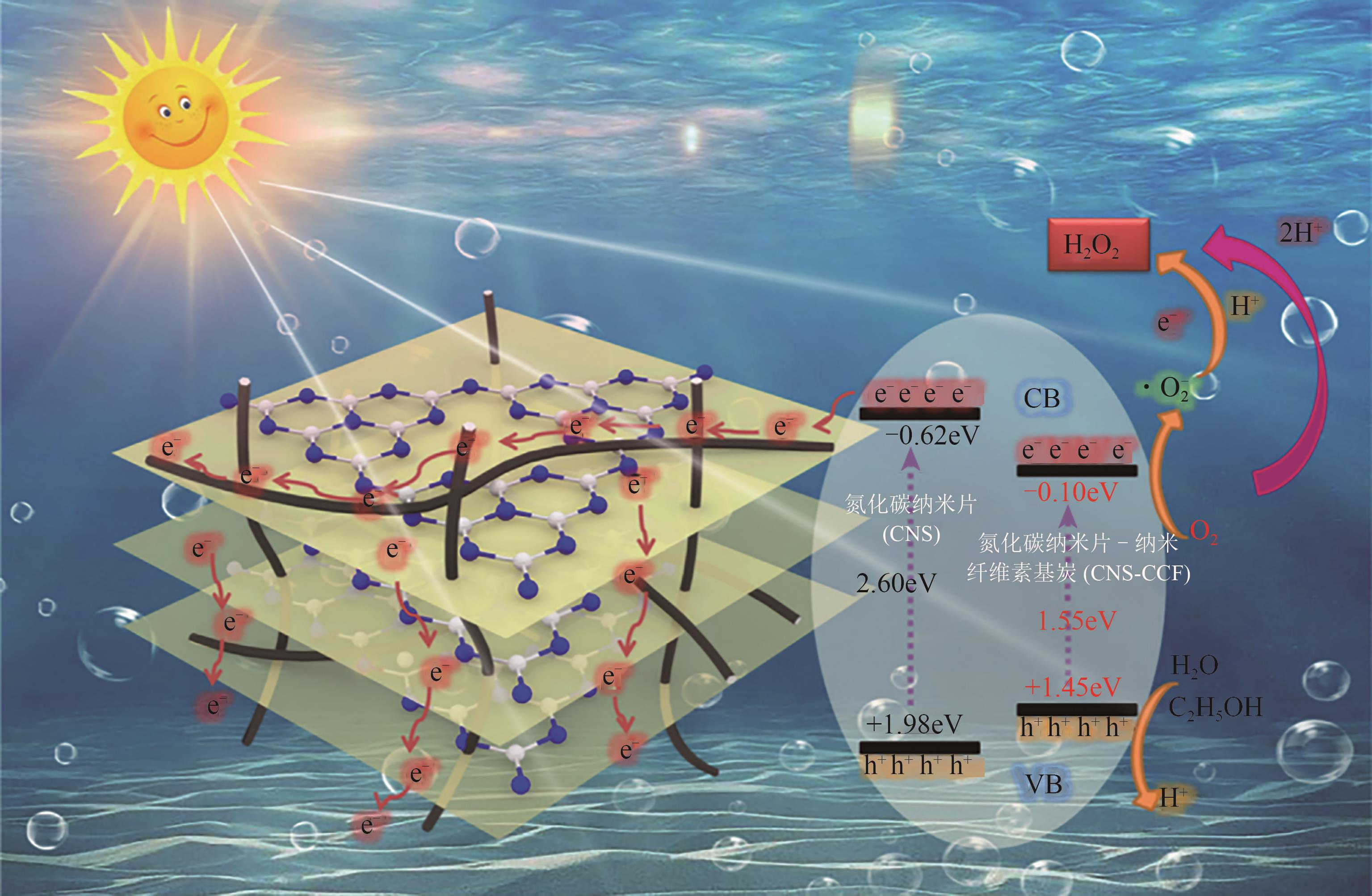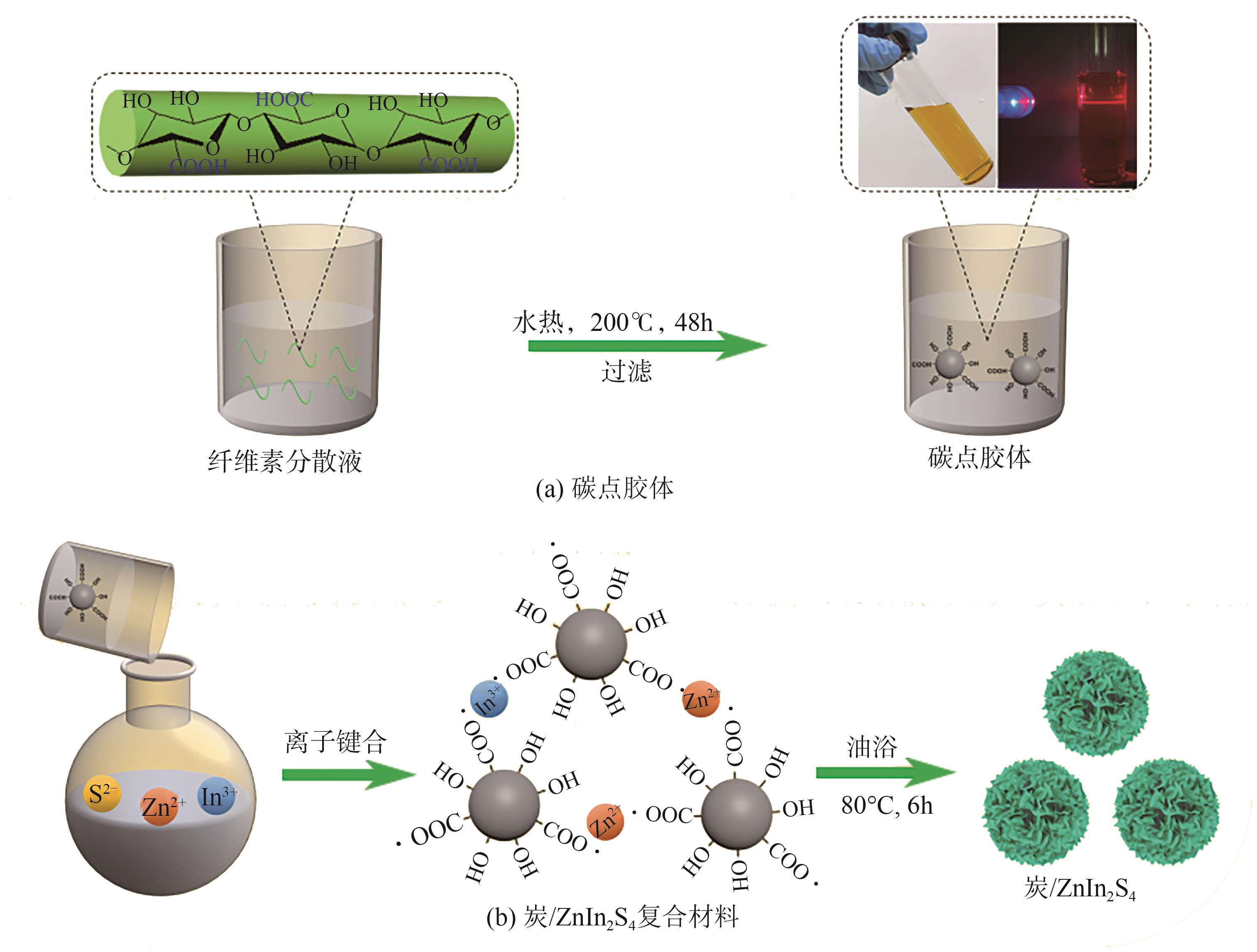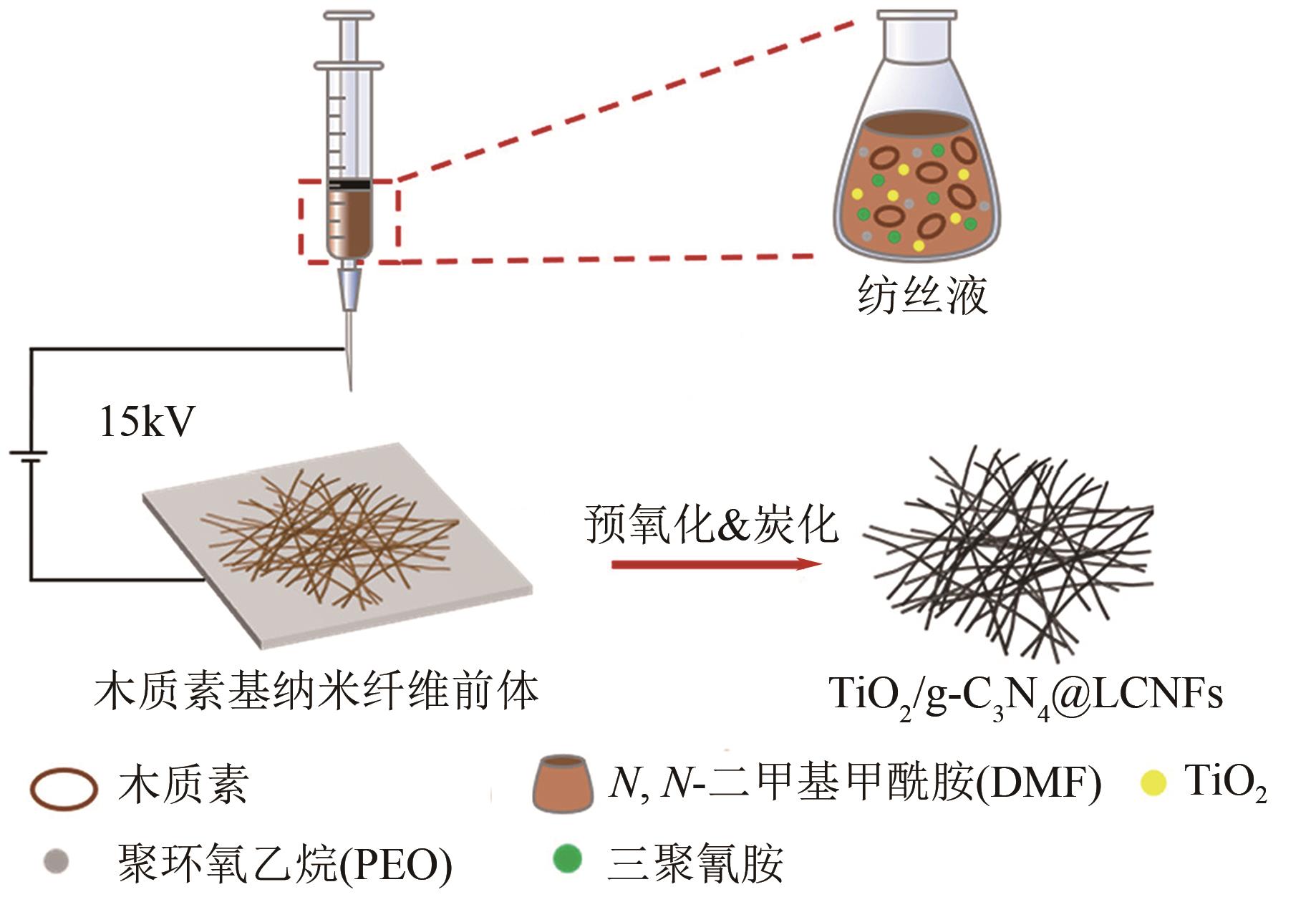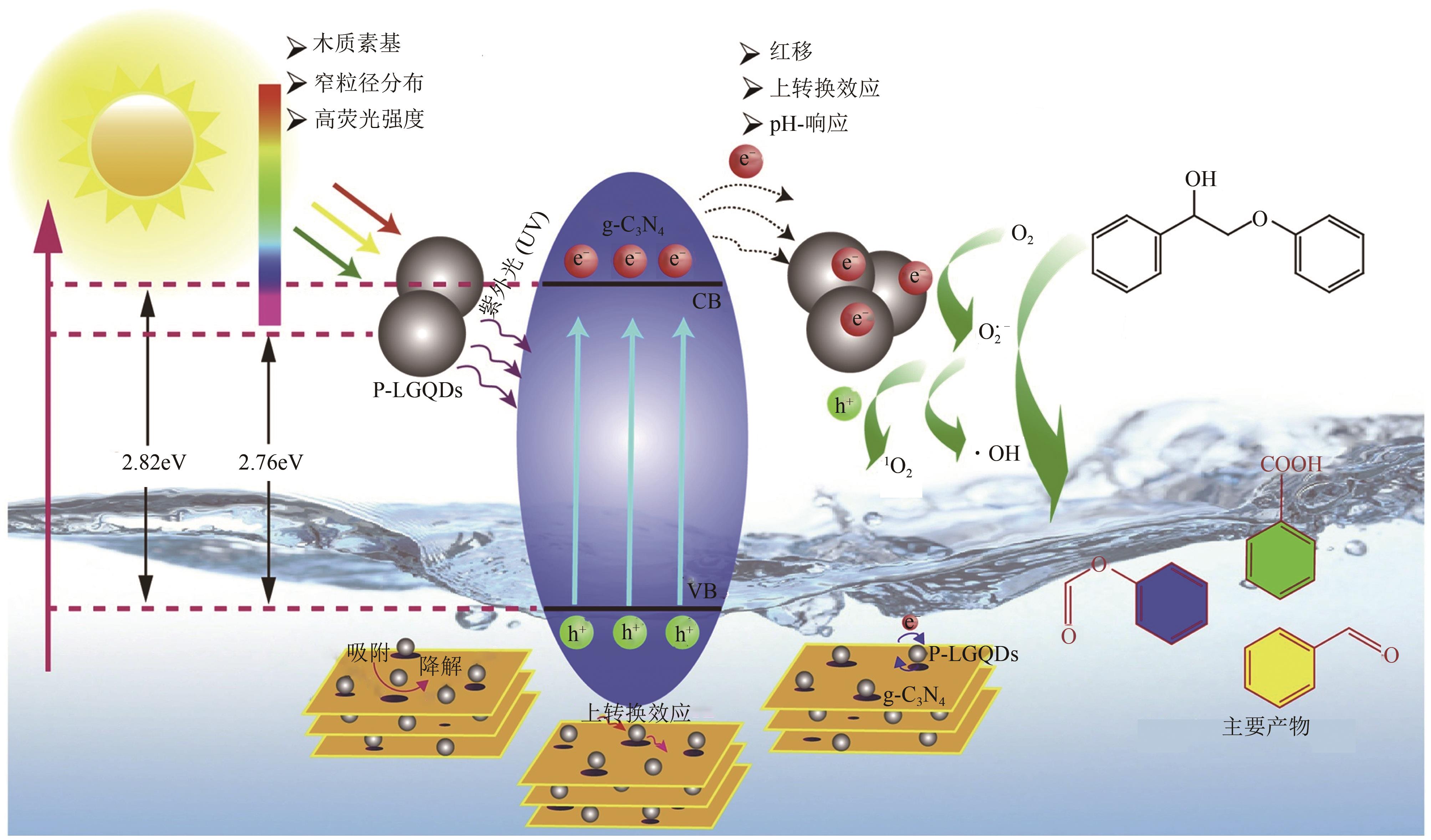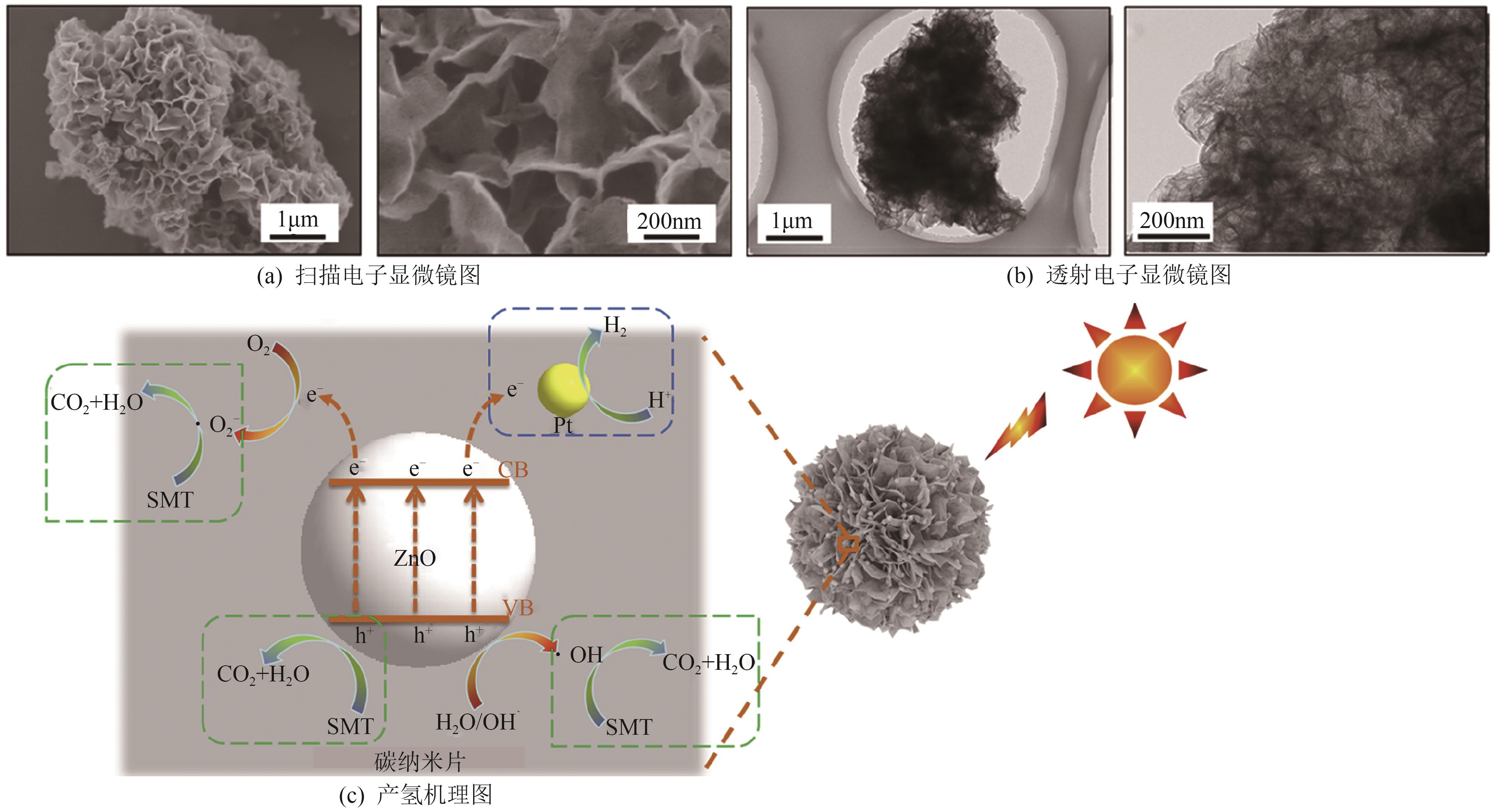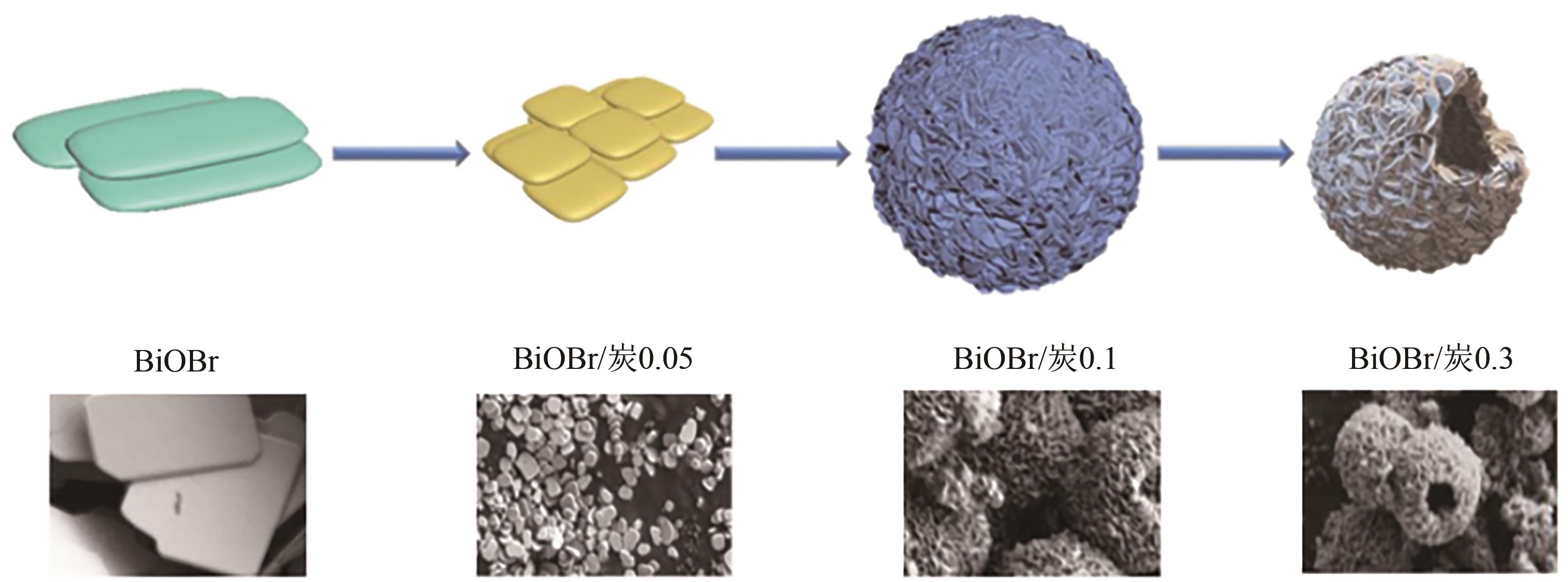化工进展 ›› 2025, Vol. 44 ›› Issue (2): 957-970.DOI: 10.16085/j.issn.1000-6613.2024-0295
木质纤维素基生物质炭改性半导体及其光催化应用
- 南京林业大学化学工程学院,江苏省林业资源高效加工利用协同创新中心,江苏 南京 210037
-
收稿日期:2024-02-19修回日期:2024-03-24出版日期:2025-02-25发布日期:2025-03-10 -
通讯作者:邱健豪,姚建峰 -
作者简介:方碧瑶(2002—),女,硕士研究生,研究方向为光催化材料构筑及应用。E-mail:byaofang@qq.com。 -
基金资助:江苏省林业科技创新与推广项目(LYKJ[2021]04);国家自然科学基金(32371812);江苏省自然科学基金(BK20210628)
Lignocellulose-derived biochar-modified semiconductors and their photocatalytic applications
FANG Biyao( ), QIU Jianhao(
), QIU Jianhao( ), LI Yixin, YAO Jianfeng(
), LI Yixin, YAO Jianfeng( )
)
- College of Chemical Engineering, Jiangsu Co-innovation Center of Efficient Processing and Utilization of Forest Resources, Nanjing Forestry University, Nanjing 210037, Jiangsu, China
-
Received:2024-02-19Revised:2024-03-24Online:2025-02-25Published:2025-03-10 -
Contact:QIU Jianhao, YAO Jianfeng
摘要:
因木质纤维素基生物质炭具有表面官能团丰富、结构易于调控及化学性质稳定等优点,其被广泛应用于催化、吸附及电化学等领域。其中,在光催化材料的构筑中,生物质炭能够改善半导体吸光差、光生载流子分离效率低、活性位点较少、比表面积较小等问题,进而优化其光催化性能。本文重点讨论了纤维素和木质素基生物质炭用于不同半导体(TiO2、g-C3N4及ZnO等)的改性,改性方式包括复合改性和掺杂改性,复合改性又分为碳点复合和以炭为载体两种形式。同时,详细介绍了改性后的催化剂在各种光催化应用[光催化有机污染物降解、Cr(Ⅵ)还原、产氢及产H2O2等]中的性能表现。最后,从催化材料设计和光催化应用角度分别讨论了木质纤维素基生物质炭改性半导体用于光催化的研究现状及存在的问题,并提出了相应的解决方案。另外,还展望了该领域的未来发展前景。本文能够为生物质衍生炭的应用及光催化材料的设计提供较为深入的见解和指引。
中图分类号:
引用本文
方碧瑶, 邱健豪, 李伊馨, 姚建峰. 木质纤维素基生物质炭改性半导体及其光催化应用[J]. 化工进展, 2025, 44(2): 957-970.
FANG Biyao, QIU Jianhao, LI Yixin, YAO Jianfeng. Lignocellulose-derived biochar-modified semiconductors and their photocatalytic applications[J]. Chemical Industry and Engineering Progress, 2025, 44(2): 957-970.
| 半导体 | 形态 | 制备方法 | 应用 | 降解/生成率 | 光源 | 参考文献 |
|---|---|---|---|---|---|---|
| TiO2 | 片状 | 焙烧 | 四环素降解 | 100% | 可见光 | [ |
| TiO2 | 块状 | 焙烧 | Cr(Ⅵ)还原 | 100% | 可见光 | [ |
| TiO2 | 珠状 | 焙烧 | 头孢曲松钠降解 | 91.92% | 可见光 | [ |
| TiO2 | 原子 | 焙烧 | 二嗪磷降解 | 98.34% | 可见光 | [ |
| TiO2 | 原子 | 水热 | 双酚A降解 | 79% | 太阳光 | [ |
| TiO2 | 点状 | 焙烧 | 亚甲基蓝降解 | 92% | 可见光 | [ |
| TiO2 | 点状 | 水热 | 罗丹明B降解、Cr(Ⅵ)还原 | 84%(膜)/100%(气凝胶) | 可见光 | [ |
| TiO2 | 原子 | 水热 | 亚甲基蓝降解 | 85% | 可见光 | [ |
| TiO2 | 块状 | 焙烧 | 甲基橙降解 | 100% | 紫外光 | [ |
| g-C3N4 | 纤维状 | 焙烧 | H2O2制备 | 1.1mmol·L-1·h-1 | 可见光 | [ |
| g-C3N4 | 纤维状 | 焙烧 | H2O2制备 | 58.67μmol·L-1·h-1 | 可见光 | [ |
| g-C3N4 | 纳米管状 | 水热 | 双酚A降解 | 91% | 可见光 | [ |
| g-C3N4 | 块状 | 水热 | 亚甲基蓝降解 | 72.04% | 可见光 | [ |
| g-C3N4 | 原子 | 焙烧 | H2制备 | 1.41mmol·L-1·h-1 | 可见光 | [ |
| g-C3N4 | 纤维状 | 水热 | 亚甲基蓝降解 | 99.9% | 可见光 | [ |
| ZnO | 点状 | 水热 | 亚甲基蓝降解 | 100% | 太阳光 | [ |
| ZnO | 点状 | 水热 | Cr(Ⅵ)还原 | 96.2% | 紫外光 | [ |
| ZnO | 棒状 | 焙烧 | 苯酚降解 | 99.8% | 可见光 | [ |
| ZnO | 原子 | 焙烧 | 甲基橙降解 | 79.78% | 紫外光 | [ |
| ZnO | 原子 | 水热 | 亚甲基蓝降解 | 100% | 紫外光 | [ |
| ZnIn2S4 | 点状 | 水热 | 5-羟甲基糠醛氧化 | 2980μmol·g-1 | 可见光 | [ |
| Fe2O3 | 点状 | 脱水氧化 | 靛蓝胭脂红降解 | 100% | 可见光 | [ |
| α-FeOOH | 点状 | 水热 | Cr(Ⅵ)还原 | 100% | 紫外光 | [ |
| SiO2 | 块状 | 焙烧 | 四环素降解 | 90% | 可见光 | [ |
| CoFe2O4 | 球状 | 水热 | 罗丹明B降解 | 100% | 可见光 | [ |
| BiOBr | 纤维状 | 焙烧 | 罗丹明B降解 | 100% | 可见光 | [ |
| ZrO2 | 原子 | 焙烧 | Cr(Ⅵ)还原 | 99.8% | 可见光 | [ |
| Ni/NiO | 块状 | 焙烧 | H2制备 | 13.5mmol·g-1·h-1 | 可见光 | [ |
| SrTiO3 | 纤维状 | 焙烧 | 四环素降解 | 99.7% | 紫外光 | [ |
表1 纤维素基炭改性半导体及其光催化应用
| 半导体 | 形态 | 制备方法 | 应用 | 降解/生成率 | 光源 | 参考文献 |
|---|---|---|---|---|---|---|
| TiO2 | 片状 | 焙烧 | 四环素降解 | 100% | 可见光 | [ |
| TiO2 | 块状 | 焙烧 | Cr(Ⅵ)还原 | 100% | 可见光 | [ |
| TiO2 | 珠状 | 焙烧 | 头孢曲松钠降解 | 91.92% | 可见光 | [ |
| TiO2 | 原子 | 焙烧 | 二嗪磷降解 | 98.34% | 可见光 | [ |
| TiO2 | 原子 | 水热 | 双酚A降解 | 79% | 太阳光 | [ |
| TiO2 | 点状 | 焙烧 | 亚甲基蓝降解 | 92% | 可见光 | [ |
| TiO2 | 点状 | 水热 | 罗丹明B降解、Cr(Ⅵ)还原 | 84%(膜)/100%(气凝胶) | 可见光 | [ |
| TiO2 | 原子 | 水热 | 亚甲基蓝降解 | 85% | 可见光 | [ |
| TiO2 | 块状 | 焙烧 | 甲基橙降解 | 100% | 紫外光 | [ |
| g-C3N4 | 纤维状 | 焙烧 | H2O2制备 | 1.1mmol·L-1·h-1 | 可见光 | [ |
| g-C3N4 | 纤维状 | 焙烧 | H2O2制备 | 58.67μmol·L-1·h-1 | 可见光 | [ |
| g-C3N4 | 纳米管状 | 水热 | 双酚A降解 | 91% | 可见光 | [ |
| g-C3N4 | 块状 | 水热 | 亚甲基蓝降解 | 72.04% | 可见光 | [ |
| g-C3N4 | 原子 | 焙烧 | H2制备 | 1.41mmol·L-1·h-1 | 可见光 | [ |
| g-C3N4 | 纤维状 | 水热 | 亚甲基蓝降解 | 99.9% | 可见光 | [ |
| ZnO | 点状 | 水热 | 亚甲基蓝降解 | 100% | 太阳光 | [ |
| ZnO | 点状 | 水热 | Cr(Ⅵ)还原 | 96.2% | 紫外光 | [ |
| ZnO | 棒状 | 焙烧 | 苯酚降解 | 99.8% | 可见光 | [ |
| ZnO | 原子 | 焙烧 | 甲基橙降解 | 79.78% | 紫外光 | [ |
| ZnO | 原子 | 水热 | 亚甲基蓝降解 | 100% | 紫外光 | [ |
| ZnIn2S4 | 点状 | 水热 | 5-羟甲基糠醛氧化 | 2980μmol·g-1 | 可见光 | [ |
| Fe2O3 | 点状 | 脱水氧化 | 靛蓝胭脂红降解 | 100% | 可见光 | [ |
| α-FeOOH | 点状 | 水热 | Cr(Ⅵ)还原 | 100% | 紫外光 | [ |
| SiO2 | 块状 | 焙烧 | 四环素降解 | 90% | 可见光 | [ |
| CoFe2O4 | 球状 | 水热 | 罗丹明B降解 | 100% | 可见光 | [ |
| BiOBr | 纤维状 | 焙烧 | 罗丹明B降解 | 100% | 可见光 | [ |
| ZrO2 | 原子 | 焙烧 | Cr(Ⅵ)还原 | 99.8% | 可见光 | [ |
| Ni/NiO | 块状 | 焙烧 | H2制备 | 13.5mmol·g-1·h-1 | 可见光 | [ |
| SrTiO3 | 纤维状 | 焙烧 | 四环素降解 | 99.7% | 紫外光 | [ |
| 半导体 | 形态 | 制备方法 | 应用 | 降解/生成率 | 光源 | 参考文献 |
|---|---|---|---|---|---|---|
| TiO2 | 块状 | 水热 | 亚甲基蓝降解 | 100% | 可见光 | [ |
| TiO2 | 球状 | 水热 | 布洛芬、双氯芬酸降解 | 100%/100% | 太阳光 | [ |
| TiO2 | 块状 | — | 对乙酰氨基酚降解 | 43.3% | 太阳光 | [ |
| TiO2 | 纤维状 | 焙烧 | 罗丹明B降解 | 100% | 可见光 | [ |
| g-C3N4 | 点状 | 水热 | Cr(Ⅵ)还原、左氟沙星降解 | 100%/94.8% | 可见光 | [ |
| g-C3N4 | 点状 | 焙烧 | 亚甲基蓝、木质素降解 | 94.6%/93.1% | 可见光 | [ |
| g-C3N4 | 块状 | 焙烧 | 四环素降解 | 87.05% | 可见光 | [ |
| ZnO | 块状 | 焙烧 | 甲基橙 | 100% | 太阳光 | [ |
| ZnO | 片状 | 焙烧 | 甲基橙降解 | 100% | 太阳光 | [ |
| ZnO | 块状 | 焙烧 | 亚甲基蓝降解 | 96.3% | 可见光 | [ |
| ZnO | 花状 | 焙烧 | 磺胺二甲嘧啶降解、H2制备 | 95%/29.0μmol·h-1 | 太阳光 | [ |
| BiOBr | 块状 | 水热 | 四环素降解、Cr(Ⅵ)还原 | 78.1%/100% | 可见光 | [ |
| BiOBr | 原子 | 水热 | 罗丹明B降解 | 99.2% | 可见光 | [ |
| Bi2O3 | 原子 | 焙烧 | 土霉素降解 | 40% | 可见光 | [ |
表2 木质素基炭改性半导体及其光催化应用
| 半导体 | 形态 | 制备方法 | 应用 | 降解/生成率 | 光源 | 参考文献 |
|---|---|---|---|---|---|---|
| TiO2 | 块状 | 水热 | 亚甲基蓝降解 | 100% | 可见光 | [ |
| TiO2 | 球状 | 水热 | 布洛芬、双氯芬酸降解 | 100%/100% | 太阳光 | [ |
| TiO2 | 块状 | — | 对乙酰氨基酚降解 | 43.3% | 太阳光 | [ |
| TiO2 | 纤维状 | 焙烧 | 罗丹明B降解 | 100% | 可见光 | [ |
| g-C3N4 | 点状 | 水热 | Cr(Ⅵ)还原、左氟沙星降解 | 100%/94.8% | 可见光 | [ |
| g-C3N4 | 点状 | 焙烧 | 亚甲基蓝、木质素降解 | 94.6%/93.1% | 可见光 | [ |
| g-C3N4 | 块状 | 焙烧 | 四环素降解 | 87.05% | 可见光 | [ |
| ZnO | 块状 | 焙烧 | 甲基橙 | 100% | 太阳光 | [ |
| ZnO | 片状 | 焙烧 | 甲基橙降解 | 100% | 太阳光 | [ |
| ZnO | 块状 | 焙烧 | 亚甲基蓝降解 | 96.3% | 可见光 | [ |
| ZnO | 花状 | 焙烧 | 磺胺二甲嘧啶降解、H2制备 | 95%/29.0μmol·h-1 | 太阳光 | [ |
| BiOBr | 块状 | 水热 | 四环素降解、Cr(Ⅵ)还原 | 78.1%/100% | 可见光 | [ |
| BiOBr | 原子 | 水热 | 罗丹明B降解 | 99.2% | 可见光 | [ |
| Bi2O3 | 原子 | 焙烧 | 土霉素降解 | 40% | 可见光 | [ |
| 1 | FUJISHIMA Akira, HONDA Kenichi. Electrochemical photolysis of water at a semiconductor electrode[J]. Nature, 1972, 238(5358): 37-38. |
| 2 | QIU Jianhao, ZHANG Xingguang, FENG Yi, et al. Modified metal-organic frameworks as photocatalysts[J]. Applied Catalysis B: Environmental, 2018, 231: 317-342. |
| 3 | QIU Jianhao, DAI Dingliang, YAO Jianfeng. Tailoring metal-organic frameworks for photocatalytic H2O2 production[J]. Coordination Chemistry Reviews, 2024, 501: 215597. |
| 4 | ACHARYA Rashmi, PARIDA Kulamani. A review on TiO2/g-C3N4 visible-light- responsive photocatalysts for sustainable energy generation and environmental remediation[J]. Journal of Environmental Chemical Engineering, 2020, 8(4): 103896. |
| 5 | QIU Jianhao, LI Ming, DING Meili, et al. Cellulose tailored semiconductors for advanced photocatalysis[J]. Renewable and Sustainable Energy Reviews, 2022, 154: 111820. |
| 6 | 王雪, 徐期勇, 张超. 木质纤维素类生物质水热炭化机理及水热炭应用进展[J]. 化工进展, 2023, 42(5): 2536-2545. |
| WANG Xue, XU Qiyong, ZHANG Chao. Hydrothermal carbonization of the lignocellulosic biomass and application of the hydro-char[J]. Chemical Industry and Engineering Progress, 2023, 42(5): 2536-2545. | |
| 7 | QIU Jianhao, LI Ming, YANG Lvye, et al. Facile construction of three-dimensional netted ZnIn2S4 by cellulose nanofibrils for efficiently photocatalytic reduction of Cr(Ⅵ)[J]. Chemical Engineering Journal, 2019, 375: 121990. |
| 8 | LI Ming, QIU Jianhao, XU Jie, et al. Cellulose/TiO 2 -based carbonaceous composite film and aerogel for highly efficient photocatalysis under visible light[J]. Industrial & Engineering Chemistry Research, 2020, 59(31): 13997-14003. |
| 9 | ULUM Bahrul, ILYAS Sultan, FAHRI Ahmad Nurul, et al. Composite carbon-lignin/zinc oxide nanocrystalline ball-like hexagonal mediated from jatropha curcas leaf as photocatalyst for industrial dye degradation[J]. Journal of Inorganic and Organometallic Polymers and Materials, 2020, 30(12): 4905-4916. |
| 10 | ARAÚJO Tiago Cabral, S OLIVEIRA Henrique DOS, TELES José Joaquim Sá, et al. Hybrid heterostructures based on hematite and highly hydrophilic carbon dots with photocatalytic activity[J]. Applied Catalysis B: Environmental, 2016, 182: 204-212. |
| 11 | WANG Chengwei, YU Ruobing. Highly efficient visible light photocatalysis of tablet-like carbon-doped TiO2 photocatalysts via pyrolysis of cellulose/MIL-125(Ti) at low temperature[J]. Journal of Solid State Chemistry, 2022, 309: 122992. |
| 12 | 庄雨婷, 王建华, 向智艳, 等. 半纤维素及其衍生物转化为γ-戊内酯及其动力学研究进展[J]. 化工进展, 2022, 41(7): 3519-3533. |
| ZHUANG Yuting, WANG Jianhua, XIANG Zhiyan, et al. Research progress in preparation and kinetics of γ-valerolactone synthesis from hemicellulose and its derivatives[J]. Chemical Industry and Engineering Progress, 2022, 41(7): 3519-3533. | |
| 13 | GAO Xiaohu, CUI Yuanyuan, LEVENSON Richard M, et al. In vivo cancer targeting and imaging with semiconductor quantum dots[J]. Nature Biotechnology, 2004, 22(8): 969-976. |
| 14 | CRUT Aurélien, Bénedicte GÉRON-LANDRE, BONNET Isabelle, et al. Detection of single DNA molecules by multicolor quantum-dot end-labeling[J]. Nucleic Acids Research, 2005, 33(11): e98. |
| 15 | 张凌峰, 胡忠攀, 刘歆颖, 等. TiO2基光解水析氢非贵金属共催化剂的研究[J]. 化学进展, 2016, 28(10): 1474-1488. |
| ZHANG Lingfeng, HU Zhongpan, LIU Xinying, et al. Noble-metal-free co-catalysts for TiO2-based photocatalytic H2-evolution half reaction in water splitting[J]. Progress in Chemistry, 2016, 28(10): 1474-1488. | |
| 16 | LI Ming, QIU Jianhao, YANG Lvye, et al. Fabrication of TiO2 embedded ZnIn2S4 nanosheets for efficient Cr(Ⅵ) reduction[J]. Materials Research Bulletin, 2020, 122: 110671. |
| 17 | 芦安源, 李萍, 任威宇, 等. 纳米花状BiOCOOH/g-C3N4复合材料的制备及其光降解亚甲基蓝性能研究[J]. 化工新型材料, 2022, 50(S1): 494-497. |
| LU Anyuan, LI Ping, REN Weiyu, et al. Preparation of nano-flower-shaped BIOCOOH/g-C3N4 composite and its photodegradation of methylene blue[J]. New Chemical Materials, 2022, 50(S1): 494-497. | |
| 18 | QIU Jianhao, DAI Dingliang, ZHANG Lu, et al. Photocatalytic conversion of sodium lignosulfonate into vanillin using mesoporous TiO2 derived from MIL-125[J]. Microporous and Mesoporous Materials, 2021, 319: 111043. |
| 19 | QIU Jianhao, DAI Dingliang, ZHANG Lu, et al. Inlaying metal-organic framework derived pancake-like TiO2 into three-dimensional BiOI for visible-light-driven generation of vanillin from sodium lignosulfonate[J]. Journal of Colloid and Interface Science, 2022, 605: 648-656. |
| 20 | ZHANG Jinju, LI Yanxiang, LI Lei, et al. Dual functional N-doped TiO2-carbon composite fibers for efficient removal of water pollutants[J]. ACS Sustainable Chemistry & Engineering, 2018, 6(10): 12893-12905. |
| 21 | WANG Yanfen, ZHANG Miao, YU Hai, et al. Facile fabrication of Ag/graphene oxide/TiO2 nanorod array as a powerful substrate for photocatalytic degradation and surface-enhanced Raman scattering detection[J]. Applied Catalysis B: Environmental, 2019, 252: 174-186. |
| 22 | YANG Jinhui, LUO Xiaogang. Ag-doped TiO2 immobilized cellulose-derived carbon beads: One-pot preparation, photocatalytic degradation performance and mechanism of ceftriaxone sodium[J]. Applied Surface Science, 2021, 542: 148724. |
| 23 | AMIRI Sama, ANBIA Mansoor. Enhanced degradation of diazinon in aqueous solution using C-TiO2/g-C3N4 nanocomposite under visible light: Synthesis, characterization, kinetics, and mechanism studies[J]. Materials Research Bulletin, 2023, 165: 112289. |
| 24 | MOHAMED Mohamad Azuwa, RAHMAN Nurashina Abdul, ZAIN M F M, et al. Hematite microcube decorated TiO2 nanorods as heterojunction photocatalyst with in situ carbon doping derived from polysaccharides bio-templates hydrothermal carbonization[J]. Journal of Alloys and Compounds, 2020, 820: 153143. |
| 25 | LI Haitao, HE Xiaodie, KANG Zhenhui, et al. Water-soluble fluorescent carbon quantum dots and photocatalyst design[J]. Angewandte Chemie International Edition, 2010, 49(26): 4430-4434. |
| 26 | BAKER Sheila N, BAKER Gary A. Luminescent carbon nanodots: Emergent nanolights[J]. Angewandte Chemie International Edition, 2010, 49(38): 6726-6744. |
| 27 | GONG Jingwei, GUO Yanzhu, LU Jie, et al. TEMPO oxidized nanofiber carbon quantum dots/TiO2 composites with enhanced photocatalytic activity for degradation of methylene blue[J]. Chemical Physics Letters, 2022, 788: 139297. |
| 28 | ZHANG Jian, YUAN Wei, XIA Tian, et al. A TiO2 coated carbon aerogel derived from bamboo pulp fibers for enhanced visible light photo-catalytic degradation of methylene blue[J]. Nanomaterials, 2021, 11(1): 239. |
| 29 | SHAN Yiwei, GUO Ying, WANG Yu, et al. Nanocellulose-derived carbon/g-C3N4 heterojunction with a hybrid electron transfer pathway for highly photocatalytic hydrogen peroxide production[J]. Journal of Colloid and Interface Science, 2021, 599: 507-518. |
| 30 | XIA Guanglu, QIU Jianhao, DAI Dingliang, et al. Electron-deficient covalent organic frameworks anchored on melamine sponges for visible-light‐driven H2O2 evolution[J]. AIChE Journal, 2023, 69(11): e18192. |
| 31 | ZHOU Jianwen, SHAN Tianshang, LUO Hao, et al. Enhanced single-electron transfer for efficiently photocatalytic H2O2 production over g-C3N4 decorated with TEMPO-oxidized cellulosic carbon[J]. Journal of Environmental Chemical Engineering, 2023, 11(2): 109512. |
| 32 | MOHAMED Mohamad Azuwa, ZAIN M F M, JEFFERY MINGGU Lorna, et al. Constructing bio-templated 3D porous microtubular C-doped g-C3N4 with tunable band structure and enhanced charge carrier separation[J]. Applied Catalysis B: Environmental, 2018, 236: 265-279. |
| 33 | YANG Pan, WANG Jingchuan, YUE Guozong, et al. Constructing mesoporous g-C3N4/ZnO nanosheets catalyst for enhanced visible-light driven photocatalytic activity[J]. Journal of Photochemistry and Photobiology A: Chemistry, 2020, 388: 112169. |
| 34 | JIN Zhengyuan, CHEN Jiaqi, HUANG Shaolong, et al. A facile approach to fabricating carbonaceous material/g-C3N4 composites with superior photocatalytic activity[J]. Catalysis Today, 2018, 315: 149-154. |
| 35 | DENG Puhui, LI Haiyan, WANG Zidong, et al. Enhanced photocatalytic hydrogen evolution by carbon-doped carbon nitride synthesized via the assistance of cellulose[J]. Applied Surface Science, 2020, 504: 144454. |
| 36 | DOU Tianwei, ZANG Linlin, ZHANG Yanhong, et al. Hybrid g-C3N4 nanosheet/carbon paper membranes for the photocatalytic degradation of methylene blue[J]. Materials Letters, 2019, 244: 151-154. |
| 37 | ZHAO Siwei, ZUO Hongfen, GUO Yuanru, et al. Carbon-doped ZnO aided by carboxymethyl cellulose: Fabrication, photoluminescence and photocatalytic applications[J]. Journal of Alloys and Compounds, 2017, 695: 1029-1037. |
| 38 | QIU Jianhao, LI Ming, WAN Yiling, et al. One-pot fabrication of Cd x Zn1- x S/ZnO nanohybrid using mixed sulfur sources for photocatalysis[J]. Materials Research Bulletin, 2020, 125: 110776. |
| 39 | LI Shaopeng, CHEN Xueqi, CHENG Zhuoying, et al. Promoting effect of cellulose-based carbon dots at different concentrations on multifunctional photocatalytic degradation of dyes by ZnO[J]. Optical Materials, 2021, 121: 111591. |
| 40 | ZHANG Xuefeng, PENG Junwen, QI Xinmiao, et al. Nanocellulose/carbon dots hydrogel as superior intensifier of ZnO/AgBr nanocomposite with adsorption and photocatalysis synergy for Cr(Ⅵ) removal[J]. International Journal of Biological Macromolecules, 2023, 233: 123566. |
| 41 | SONG Li, LIU Fuqiang, ZHU Changqing, et al. Facile one-step fabrication of carboxymethyl cellulose based hydrogel for highly efficient removal of Cr(Ⅵ) under mild acidic condition[J]. Chemical Engineering Journal, 2019, 369: 641-651. |
| 42 | PENG Junwen, YUAN Hanmeng, REN Tingting, et al. Fluorescent nanocellulose-based hydrogel incorporating titanate nanofibers for sorption and detection of Cr(Ⅵ)[J]. International Journal of Biological Macromolecules, 2022, 215: 625-634. |
| 43 | ZHANG Yin, ZHAO Guomin, XUAN Yan, et al. Enhanced photocatalytic performance for phenol degradation using ZnO modified with nano-biochar derived from cellulose nanocrystals[J]. Cellulose, 2021, 28(2): 991-1009. |
| 44 | XIAO He, ZHANG Weibo, WEI Yicui, et al. Carbon/ZnO nanorods composites templated by TEMPO-oxidized cellulose and photocatalytic activity for dye degradation[J]. Cellulose, 2018, 25(3): 1809-1819. |
| 45 | QIU Jianhao, ZHANG Lu, DAI Dingliang, et al. Cellulose-derived carbon dot-guided growth of ZnIn2S4 nanosheets for photocatalytic oxidation of 5-hydroxymethylfurfural into 2,5-diformylfuran[J]. ChemSusChem, 2022, 15(10): e202200399. |
| 46 | XU Dong, HUANG Yong, MA Qiang, et al. A 3D porous structured cellulose nanofibrils-based hydrogel with carbon dots-enhanced synergetic effects of adsorption and photocatalysis for effective Cr(Ⅵ) removal[J]. Chemical Engineering Journal, 2023, 456: 141104. |
| 47 | REN Jiaxin, CHEN Shipeng, LI Delong, et al. Hierarchically porous cellulose-based carbon aerogels with N-doped skeletons and encapsulated iron-based catalysts for efficient tetracycline catalytic degradation[J]. International Journal of Biological Macromolecules, 2024, 261:129829. |
| 48 | GAN Lu, GENG Aobo, XU Lijie, et al. The fabrication of bio-renewable and recyclable cellulose based carbon microspheres incorporated by CoFe2O4 and the photocatalytic properties[J]. Journal of Cleaner Production, 2018, 196: 594-603. |
| 49 | GENG Aobo, MENG Liang, HAN Jingquan, et al. Highly efficient visible-light photocatalyst based on cellulose derived carbon nanofiber/BiOBr composites[J]. Cellulose, 2018, 25(7): 4133-4144. |
| 50 | VELEMPINI Tarisai, PRABAKARAN Eswaran, PILLAY Kriveshini. Photocatalytic reductive applications of C-doped ZrO2/PANI composite towards Cr(Ⅵ)[J]. Journal of Photochemistry and Photobiology A: Chemistry, 2022, 426: 113737. |
| 51 | XIE Kaihong, GUO Peijing, XIONG Zhangyi, et al. Ni/NiO hybrid nanostructure supported on biomass carbon for visible-light photocatalytic hydrogen evolution[J]. Journal of Materials Science, 2021, 56(22): 12775-12788. |
| 52 | WU Qiong, LI Wei, TAN Jia, et al. Hydrothermal synthesis of magnetic mesoporous carbon microspheres from carboxymethylcellulose and nickel acetate[J]. Applied Surface Science, 2015, 332: 354-361. |
| 53 | LIU Yuepeng, ZHAO Shuo, ZHANG Chao, et al. Hollow tubular carbon doping graphitic carbon nitride with adjustable structure for highly enhanced photocatalytic hydrogen production[J]. Carbon, 2021, 182: 287-296. |
| 54 | HAMAD Hesham, Esther BAILÓN-GARCÍA, Sergio MORALES-TORRES, et al. Functionalized cellulose for the controlled synthesis of novel carbon-Ti nanocomposites: Physicochemical and photocatalytic properties[J]. Nanomaterials, 2020, 10(4): 729. |
| 55 | ZHOU Man, CHEN Jingwen, JIANG Mengting, et al. Efficient anchoring of SrTiO3 on the cracked surface of carbonized bacterial cellulose for enhanced photocatalytic activities[J]. Cellulose, 2020, 27(12): 7023-7036. |
| 56 | WANG Huan, QIU Xueqing, LIU Weifeng, et al. Facile preparation of well-combined lignin-based carbon/ZnO hybrid composite with excellent photocatalytic activity[J]. Applied Surface Science, 2017, 426: 206-216. |
| 57 | GAO Xin, REN Penggang, WANG Jin, et al. Fabrication of visible-light responsive TiO2@C photocatalyst with an ultra-thin carbon layer to efficiently degrade organic pollutants[J]. Applied Surface Science, 2020, 532: 147482. |
| 58 | Manuel PEÑAS-GARZÓN, ABDELRAHEEM Wael H M, BELVER Carolina, et al. TiO2-carbon microspheres as photocatalysts for effective remediation of pharmaceuticals under simulated solar light[J]. Separation and Purification Technology, 2021, 275: 119169. |
| 59 | ZHAI Gongxun, ZHOU Jialiang, XIE Min, et al. Improved photocatalytic property of lignin-derived carbon nanofibers through catalyst synergy[J]. International Journal of Biological Macromolecules, 2023, 233: 123588. |
| 60 | ZHU Lingli, SHEN Dekui, ZHANG Huiyan, et al. Fabrication of Z-scheme Bi7O9I3/g-C3N4 heterojunction modified by carbon quantum dots for synchronous photocatalytic removal of Cr(Ⅵ) and organic pollutants[J]. Journal of Hazardous Materials, 2023, 446: 130663. |
| 61 | LIU Wei, NING Chenxi, SANG Ranran, et al. Lignin-derived graphene quantum dots from phosphous acid-assisted hydrothermal pretreatment and their application in photocatalysis[J]. Industrial Crops and Products, 2021, 171: 113963. |
| 62 | XU Ying, LI Wei, XU Ting, et al. Straightforward fabrication of lignin-derived carbon-bridged graphitic carbon nitride for improved visible photocatalysis of tetracycline hydrochloride assisted by peroxymonosulfate activation[J]. Advanced Composites and Hybrid Materials, 2023, 6(6): 197. |
| 63 | WANG Huan, QIU Xueqing, ZHONG Ruisheng, et al. One-pot in situ preparation of a lignin-based carbon/ZnO nanocomposite with excellent photocatalytic performance[J]. Materials Chemistry and Physics, 2017, 199: 193-202. |
| 64 | ZHANG Binpeng, YANG Dongjie, QIU Xueqing, et al. Fabricating ZnO/lignin-derived flower-like carbon composite with excellent photocatalytic activity and recyclability[J]. Carbon, 2020, 162: 256-266. |
| 65 | SUN Yiming, WU Weidong, ZHOU Haifeng. Lignosulfonate-controlled BiOBr/C hollow microsphere photocatalyst for efficient removal of tetracycline and Cr(Ⅵ) under visible light[J]. Chemical Engineering Journal, 2023, 453: 139819. |
| 66 | YANG Qiang, LI Xiang, TIAN Qingwen, et al. Synergistic effect of adsorption and photocatalysis of BiOBr/lignin-biochar composites with oxygen vacancies under visible light irradiation[J]. Journal of Industrial and Engineering Chemistry, 2023, 117: 117-129. |
| 67 | WANG Tao, LIU Xiqing, HAN Donglai, et al. Biomass derived the V-doped carbon/Bi2O3 composite for efficient photocatalysts[J]. Environmental Research, 2020, 182: 108998. |
| 68 | Manuel PEÑAS-GARZÓN, Almudena GÓMEZ-AVILÉS, BEDIA Jorge, et al. Effect of activating agent on the properties of TiO2/activated carbon heterostructures for solar photocatalytic degradation of acetaminophen[J]. Materials, 2019, 12(3): 378. |
| 69 | QIU Jianhao, LI Ming, WANG Huanting, et al. Integration of plasmonic effect into MIL-125-NH2: An ultra-efficient photocatalyst for simultaneous removal of ternary system pollutants[J]. Chemosphere, 2020, 242: 125197. |
| 70 | QIU Jianhao, DAI Dingliang, ZHANG Lu, et al. Oxygen vacancy-rich Bi2MoO6 anchored on cuboid metal-organic frameworks for photocatalytic elimination of Cr(Ⅵ)/2-nitrophenol mixed pollutants[J]. Separation and Purification Technology, 2022, 301: 121990. |
| 71 | DAI Dingliang, QIU Jianhao, XIA Guanglu, et al. Competitive coordination initiated one-pot synthesis of core shell Bi-MOF@BiOX (X=I, Br and Cl) heterostructures for photocatalytic elimination of mixed pollutants[J]. Separation and Purification Technology, 2023, 316: 123819. |
| [1] | 刘炜, 张敏, 朱照琪, 王毅, 梁卫东, 孙寒雪. 黑色二氧化钛纳米材料的构筑及其应用现状[J]. 化工进展, 2025, 44(1): 341-353. |
| [2] | 蒋莉萍, 张雪乔, 钟晓娟, 魏于凡, 肖利, 郭旭晶, 羊依金. 钒渣酸浸提铁工艺优化及复合光催化剂的制备[J]. 化工进展, 2025, 44(1): 538-548. |
| [3] | 韩洪晶, 车宇, 田宇轩, 王海英, 张亚男, 陈彦广. 木质素催化氢解催化剂及溶剂的研究进展[J]. 化工进展, 2024, 43(S1): 315-324. |
| [4] | 万震, 王绍庆, 李志合, 赵天生. HZSM-5分子筛催化木质素热解制芳烃研究进展[J]. 化工进展, 2024, 43(S1): 517-532. |
| [5] | 陈慕华, 嵇震, 王芳, 黄凯健, 付博, 刘博, 刘绍忠, 朱新宝. 纤维素基共聚型聚羧酸减水剂的合成及其性能[J]. 化工进展, 2024, 43(S1): 564-570. |
| [6] | 吴泽亮, 管琦卉, 陈世霞, 王珺. 炔烃选择性加氢制烯烃反应的研究进展[J]. 化工进展, 2024, 43(8): 4366-4381. |
| [7] | 付涛, 李立, 高莉宁, 朱富维, 曹炜烨, 陈华鑫. 水泥基硼掺杂石墨相氮化碳降解NO[J]. 化工进展, 2024, 43(8): 4403-4410. |
| [8] | 武哲, 曲树光, 冯练享, 曾湘楚. 海藻酸钠/微晶纤维素复合水凝胶对水中甲基橙和亚甲基蓝的吸附性能与机理[J]. 化工进展, 2024, 43(8): 4681-4693. |
| [9] | 毛华恺, 余洋, 张悦, 夏广坤, 吴赟韬, 楼乐瑶, 牛文娟, 刘念. 生物炭光催化氧化-吸附协同降解亚硝酸盐[J]. 化工进展, 2024, 43(8): 4757-4765. |
| [10] | 舒岗韦, 林钰程, 张为宏, 赵世强, 郑晓阳, 常春. 木糖生物炼制与高值化应用研究进展[J]. 化工进展, 2024, 43(7): 3798-3811. |
| [11] | 张世蕊, 范朕连, 宋慧平, 张丽娜, 高宏宇, 程淑艳, 程芳琴. 粉煤灰负载光催化材料的研究进展[J]. 化工进展, 2024, 43(7): 4043-4058. |
| [12] | 陈志强, 夏明巍, 杨海平, 陈应泉, 王贤华, 陈汉平. 木质纤维素基碳量子点合成与调控研究进展[J]. 化工进展, 2024, 43(6): 3100-3113. |
| [13] | 龚雪梅, 蒋军, 王超, 梅长彤. 纳米纤维素疏水改性及其功能化应用研究进展[J]. 化工进展, 2024, 43(6): 3187-3198. |
| [14] | 谢国平, 谭雪松, 刘鹏, 苗长林, 许光文, 庄新姝. 基于生物基衍生有机溶剂的木质纤维素预处理研究进展[J]. 化工进展, 2024, 43(6): 3347-3358. |
| [15] | 冯飞飞, 田斌, 马鹏飞, 韦荐昕, 徐龙, 田原宇, 马晓迅. 木质素分离原理与方法研究进展[J]. 化工进展, 2024, 43(5): 2512-2525. |
| 阅读次数 | ||||||
|
全文 |
|
|||||
|
摘要 |
|
|||||
